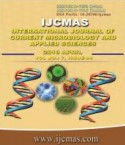


 National Academy of Agricultural Sciences (NAAS)
National Academy of Agricultural Sciences (NAAS)

|
PRINT ISSN : 2319-7692
Online ISSN : 2319-7706 Issues : 12 per year Publisher : Excellent Publishers Email : editorijcmas@gmail.com / submit@ijcmas.com Editor-in-chief: Dr.M.Prakash Index Copernicus ICV 2018: 95.39 NAAS RATING 2020: 5.38 |
An experiment was conducted during Rabi 2016-17 at Pulses Research farm, Bihar Agricultural University, Sabour (Bhagalpur) to study the existing genetic diversity in thirty six Desi chickpea genotypes under normal sown condition. All the genotypes were grouped into seven clusters as per Ward minimum variance method revealed the presence of considerable amount of genetic diversity in the material with each other for different yield and yield attributing traits. The cluster II containing the maximum of 13 genotypes followed by 9 genotypes in cluster I, 5 genotypes in cluster III, 3 genotypes each in cluster IV and V, 2 genotypes in cluster in cluster VI and mono-genotypes in cluster. The intra-cluster D2 value ranged from 0.00 to 421.27 while, inter-cluster D value ranged from 402.80 to 3912.66. The highest intra-cluster distance was exhibited by cluster I (421.27) followed by cluster VI (316.27) and III (315.69). The highest inter cluster distance was observed between cluster II and VII (3912.66) followed by cluster II and VII (3831.40), cluster III and VI (2804.51) and cluster IV and VII. The above results indicate that these genotypes have maximum genetic diversity and useful for developing a large number of segregants through crossing programme by using maximum diverse genotypes. The genotypes of cluster VII showed the highest mean values for grain yield per plant, harvest index, biological yield per plant, primary and secondary branches per plant, plant height and days to maturity, while cluster VI showed the highest mean for grain yield per plot, total number of pods per plant, effective pods per plant and days to 50% flowering. The cluster V had highest mean value for 100 seed weight and canopy temperature at vegetative stage. The cluster IV recorded highest mean value for chlorophyll index, while cluster III exhibited highest mean value for canopy temperature at pollen formation stage. The promising genotypes for grain yield per plant, harvest index, biological yield per plant, grain yield per plot, total number of pods per plant, effective pods per plant, primary and secondary branches per plant, plant height, on the basis of mean values which could be utilized for hybridization programme for the development of high yielding genotypes. Among the fifteen traits studied, maximum contribution was made by 100-seed weight (46.83%) (Table-4) followed by total number of pods per plant (22.22%), grain yield per plant (12.54%), grain yield per plot (5.34%) and harvest index (3.49%). Therefore, these characters may be given importance during hybridization programme.
 |
 |
 |
 |
 |